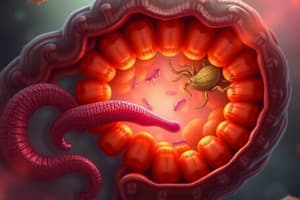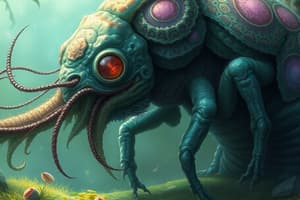Podcast
Questions and Answers
What is a key characteristic of parasites?
What is a key characteristic of parasites?
- They live on non-living organisms.
- They can survive without water.
- They do not require oxygen.
- They live on living organisms. (correct)
Which material composes the cell wall of fungi?
Which material composes the cell wall of fungi?
- Cellulose
- Peptidoglycan
- Chitin (correct)
- Keratin
In what form do fungi primarily store food?
In what form do fungi primarily store food?
- As sugars
- As starch
- As proteins
- As lipids and glycogen (correct)
What type of pH do parasites grow best in?
What type of pH do parasites grow best in?
Which of the following statements is true regarding the oxygen requirements of parasites?
Which of the following statements is true regarding the oxygen requirements of parasites?
What structures do fungi use for reproduction and survival in dry conditions?
What structures do fungi use for reproduction and survival in dry conditions?
Which of the following is NOT true about spore formation in fungi?
Which of the following is NOT true about spore formation in fungi?
Which of the following accurately describes how yeast and molds differ?
Which of the following accurately describes how yeast and molds differ?
What type of hyphae are characterized by having numerous cross-walls?
What type of hyphae are characterized by having numerous cross-walls?
Which form of fungi typically exhibits a smooth and creamy growth pattern?
Which form of fungi typically exhibits a smooth and creamy growth pattern?
Which pigment characteristic best describes hyaline mycelium?
Which pigment characteristic best describes hyaline mycelium?
Which feature is unique to aerial hyphae compared to vegetative hyphae?
Which feature is unique to aerial hyphae compared to vegetative hyphae?
What are the structures that reproduce yeast through budding called?
What are the structures that reproduce yeast through budding called?
Which description fits dimorphic fungi?
Which description fits dimorphic fungi?
What is the main role of vegetative mycelium?
What is the main role of vegetative mycelium?
Which type of hyphae is synonymous with being aseptate?
Which type of hyphae is synonymous with being aseptate?
What type of organism is associated with anthropophilic favus hyphae?
What type of organism is associated with anthropophilic favus hyphae?
What does the term 'ectothrix' refer to in relation to fungal infections?
What does the term 'ectothrix' refer to in relation to fungal infections?
Which medium is specifically designed for testing dermatophytes?
Which medium is specifically designed for testing dermatophytes?
What characteristic feature is associated with the scutula in skin infections?
What characteristic feature is associated with the scutula in skin infections?
What is the function of a wood's lamp in clinical observation?
What is the function of a wood's lamp in clinical observation?
What type of mycoses involves tissue invasion?
What type of mycoses involves tissue invasion?
Which statement is true regarding dermatomycoses?
Which statement is true regarding dermatomycoses?
What is the primary characteristic of subcutaneous mycoses?
What is the primary characteristic of subcutaneous mycoses?
Which system is primarily affected by systemic mycoses?
Which system is primarily affected by systemic mycoses?
Who is most at risk of opportunistic fungal infections?
Who is most at risk of opportunistic fungal infections?
What allows opportunistic fungi to cause infections in certain individuals?
What allows opportunistic fungi to cause infections in certain individuals?
Which of the following correctly describes systemic mycoses?
Which of the following correctly describes systemic mycoses?
What is a characteristic of both cutaneous mycoses and dermatomycoses?
What is a characteristic of both cutaneous mycoses and dermatomycoses?
What method of transmission involves inhaling fungal spores?
What method of transmission involves inhaling fungal spores?
Which of the following is NOT a part of the fungal culture process?
Which of the following is NOT a part of the fungal culture process?
What does serological testing in the fungal culture process typically assess?
What does serological testing in the fungal culture process typically assess?
Which of the following best describes inoculation in the context of fungal transmission?
Which of the following best describes inoculation in the context of fungal transmission?
Which term refers to the life cycle forms of fungi that produce asexual spores?
Which term refers to the life cycle forms of fungi that produce asexual spores?
Flashcards are hidden until you start studying
Study Notes
Overview of Parasites and Fungi
- Parasites live on living organisms and have a chitin-based cell wall.
- They store food in the form of lipids and glycogen.
- Capable of staining both gram positive and gram negative.
- Require water and oxygen for growth; not obligate anaerobes.
- Optimal growth occurs at neutral pH and in moist conditions.
- Reproduce through spores and conidia; spore for survival, conidia for reproduction.
Classification of Fungi
- Fungi exist in two main forms: yeasts and molds.
- Yeasts are smooth, creamy, or mucoid, reproduce by budding, resulting in blastoconidia.
- Molds exhibit filamentous growth due to mycelial structures.
Types of Hyphae
- Septate Hyphae: Contain numerous cross-walls.
- Coenocytic (Aseptate) Hyphae: Have few or no cross-walls.
- Mycelium: A mass of branching hyphae that functions in nutrient absorption.
- Aerial Hyphae: Filamentous, responsible for producing conidia.
- Vegetative Hyphae: Responsible for nutrient absorption from media.
Morphological Characteristics of Hyphae
- Hyaline Hyphae: Non-pigmented, clear, transparent, will appear blue when stained.
- Dematiaceous Hyphae: Pigmented, exhibiting black or brown colors without stain.
Types of Vegetative Hyphae
- Antler hyphae resemble antlers.
- Nodular hyphae appear knot-like.
- Racquet hyphae bear a resemblance to racquets.
Modes of Transmission
- Fungal spores can be produced asexually or both sexually and asexually.
- Common transmission methods include inhalation, inoculation through skin/mucous membrane, and ingestion.
Fungal Culture Process
- Involves specimen collection and direct examination.
- Requires selection, inoculation of media, and evaluation of growth.
- Includes serological and antifungal susceptibility testing.
Classification of Mycoses
- Cutaneous Mycoses/Dermatomycoses: Involve tissue invasion but do not reach systemic levels.
- Subcutaneous Mycoses: Occur under the skin.
- Systemic Mycoses: Involve multiple deep organs; can progress from superficial to internal organs.
Opportunistic Mycoses
- Typically affect individuals with lowered immunity.
- Frequently seen in patients with existing bacterial or viral infections, leading to secondary fungal infections.
Manifestations of Fungal Infections
- Ectothrix: Infection occurs outside hair.
- Endothrix: Infection occurs inside hair.
- Wood’s Lamp: Used for diagnosis via fluorescence.
- Scutula: Crusty skin lesions associated with skin infections.
Culture Techniques for Clinical Materials
- Use of specialized media such as Mycosel and DTM for dermatophyte testing.
- Cornmeal agar and slide culture help visualize colony morphology and characteristics.
Studying That Suits You
Use AI to generate personalized quizzes and flashcards to suit your learning preferences.




